This study was mainly conducted to empirically investigate the determinants of e-library end users acceptance and use in academic libraries. The introduction of new information and communication technologies in libraries during the last two decades has altogether changed the concepts of libraries where library patrons need not necessarily go to the library physically since the library services and resources are no longer confined to the walls of the physical library. However, for these e-library services to be utilized effectively and efficiently, library end users must accept and use them. The study had applied the SO-UTAUT (Services Oriented Unified Theory of Acceptance and Use of Technology) technology acceptance model which is appropriate in a library context. In this paper, we assess the acceptance and use of e-library services in academic libraries of the different universities and identify the determinant factors that affect the acceptance and use of elibrary services in academic libraries.
Keywords |
| e-library, e-journals, ICT, Technology Acceptance, End-Users, UTAUT, SOUTAUT, and PLS. |
INTRODUCTION |
| The introduction of computers and other telecommunication technologies in libraries during the last quarter of the century
has changed the concept of a library and the library profession. Information seekers are no longer confined to the walls of
the library, (Kwak, et al. 2002; Bevis, 2003; Rosenberg, 2005; Vinitha, 2006). As ascertained by Kwak, et al. (2002),
majority of university libraries in the U.S. are now hybrid libraries, depending on both electronic and print media based on
network and physical facilities. Many university libraries including some in DCs
is part of campus-wide networks, with Internet access (Alan, 1996; Kiondo, 1997; Martey, 2004; Rosenberg, 2005). Using
networked technologies, patrons can get the information required electronically from wherever it is located on the web. The
main role of a librarian is now to assist end-users in searching techniques and the use of technologies. Unlike in the
traditional library where users require the ability to read, a skill acquired during all the schooling years, in an e-library
services environment,users require to adopt ICT and have basic information searching skills. Technology has penetrated all
areas of life and the use of information and communication technology (ICT) is commonplace in the 21st century. Libraries
use ICT for better service and satisfying diverse user needs. Libraries have transformed into digital and virtual libraries
where books, journals, and magazines have changed into e-books, e-journals, and e-magazines. This has increased the
global dissemination of information. Electronic resources such as e-journals are easily accessible in remote areas.
Electronic resources solve storage problems and control the flood of information. Print sources are being digitized. The
rapid growth of new technologies has changed the communication process and reduced the cost of communication for
individuals. Electronic information sources can be seen as the most recent development in information technology.
Electronic information sources are becoming more and more important for the academic community.
University academics are a unique population and rely on recent and timely Information and electronic resources are now
used more often than print resources by them (Morse and Clintworth, 2000). Since there has been no study conducted so far
to measure the use of these e-resources by University Academic Faculty Members, thus the study aimed to examine the
extent to which of using the (OEJ) systems are in place to assure quality higher education production as perceived by the
faculty, through the following three questions: |
| 1. To what Extent University Academic members are using On-line Electronic Journals? |
| 2. Is there any statistical differences (at α = 0.05) in the usage of On-line Electronic Journals by University Academic
members regarding years of experience? |
| 3. Is there any statistical differences (at α = 0.05) in the usage of On-line Electronic Journals by University Academic
members regarding academic qualification? |
LITERATURE REVIEW |
| Borrego, et al. (2007) observes that there have been many studies of users of electronic resources in the professional
literature in the last few years. In a recent exhaustive review of the literature on the subject, Tenopir (2003) analyzed the
results of over 200 studies of the use of electronic resources in libraries published between 1995 and 2003. The main
conclusion of this review is that electronic resources have been rapidly adopted in academic spheres, though the behavior
varies according to the discipline. Smith (2003) in his article "Changes in faculty reading behaviors: The impact of
Electronic journals on the University of Georgia " aimed to explore the role of electronic journals in the weekly scholarly
reading habits of faculty. The study showed that electronic access to journals particularly library funded access is integral to
research activities, with the vast majority of respondents reported that they read at least one article from an electronic
source weekly Heterick (2002) reports that more than 60% of faculty studied are comfortable using electronic resources.
They believe that a variety of electronic resources is important to their research, and they consider electronic databases to
be invaluable. In addition, 62% expect that they will become increasingly dependent on electronic resources in the future.
The resources they use most often are online catalogs, full-text electronic journal databases, and abstracting and indexing
databases. More than 70% of all respondents consider their library's online catalogue to be "very important" to their
research. However, the importance of this resource varies significantly by field. Just over 60% of the economists consider
their library's online catalogue to
be "very important", while nearly 90% of humanists regarded it as such. In fact, the home library catalogue is the most
important electronic resource for humanists, by a large margin. Based on their replies, it is as important to their research as
personal computers. Sandra L. De Groote, M.L.I.S. and Josephine L. Dorsch, M.A.L.S.(2001)examined research Online
journals: impact on print journal usage. The research tried to determine the impact of online journals on the use of print
journals and interlibrary loan (ILL). Results of the statistical analysis showed print journal usage decreased significantly
since the introduction of online journals (F(1,147) = 12.10, P < 0.001). This decrease occurred regardless of whether a
journal was available only in print or both online and in print. Interlibrary loan requests have also significantly decreased
since the introduction of online journals (F(2,30) = 4.46, P < 0.02). |
| Blecic(1999) established a correlation between in-house use, circulation, and citation by faculty, which suggests that the
gathering of many types of data is impractical and that one method may be used with the confidence that it correlates with
other types of uses Electronic information resources are increasingly in use for cores at all levels of higher education
(Macdonald 2001). |
ON-LINE ELECTRONIC JOURNALS |
| Academics use On-line Electronic Journals for diverse purposes as demonstrated in the literature. Obaje and Camble (2008)
report that On-line Electronic Journals are mostly used for literature searches during project/dissertation and thesis writing
as well as personal research by staff. Academics at Obafemi Awolowo University, Ile-Ife, use On-line Electronic Journals
mostly for literature search in research and professional growth (Omotatyo, 2010). Kumar and Kumar (2008), however,
highlighted six reasons for using On-line Electronic Journals. Users in the study use On-line Electronic Journals in support
of their study (70%) and teaching (59%). One third of respondents used the sources for project work. (88%) medical
science users accessed OEJ sources for study, followed by engineering (67%) and management studies (55%). In Catalan
Universities, electronic journals were consulted for both research and teaching by 53.6% of the respondents to a survey.
They were consulted only for research by 37.4% and only for teaching by 2.7%. Respondents in Exact and Natural Sciences
and Engineering mainly use journals for research, whereas those in Biomedicine use them for both teaching and research.
When the results are disaggregated by age, respondents under the age 30 mainly use them for research, respondents in the
41-50 age group use them for both teaching and research, and respondents over 51 use them for teaching and research or
only for teaching. Disaggregated by academic position, only the associate professors showed a high proportion of use for
teaching (35.9%) (Borrego et. al. 2007). |
TECHNOLOGY ACCEPTANCE MODEL (TAM) |
| The Technology Acceptance Model (TAM) displays how users accept and use new technology. The model describes the
factors that influence users' decisions about how and when they will use new technology, notably. Perceived usefulness
(PU) - This was defined by Fred Davis as "the degree to which a person believes that using a particular system would enhance his or her job performance". Perceived ease-of-use (PEOU) - Davis defined this as "the degree to which a person
believes that using a particular system would be free from effort" (Davis 1989).The TAM
has been continuously studied and expanded. The two major upgrades are the TAM 2 (Venkatesh & Davis 2000 &
Venkatesh 2000) and the Unified Theory of Acceptance and Use of Technology (or UTAUT, Venkatesh et al.
2003).Several researchers have replicated Davis's study to provide evidence on the relationships between usefulness, ease
of use, and system use (Adams, Nelson & Todd 1992; Davis 1989; Hendrickson, Massey & Cronan 1993; |
| Segars & Grover 1993; Subramanian 1994; Szajna 1994). Attention has focused on testing the questionnaire used by
Davis. Adams et al. ( 1992) replicated the work of Davis to demonstrate the validity and reliability of the instrument and
measurement scales. Hendrickson, et al. (1993) found high reliability and good test-retest reliability. Szajna (1994) found
the instrument valid. |
THE UNIFIED THEORY OF ACCEPTANCE AND USE OF TECHNOLOGY (UTAUT) |
| A study of the determinants found in major acceptance and use models by Vanketesh, et al. (2003) reviews the subject
literature systematically and compares eight previous models and the predictive factors specified by each. By so doing, the
authors developed a new model the “Unified Theory of Acceptance and Use of Technology model” in Figure 2. |
DEVELOPMENT OF SERVICE ORIENTED UNIFIED THEORY OF ACCEPTANCE AND USE OF
TECHNOLOGY MODEL (SO-UTAUT): |
| We further use path coefficients and R2 to evaluate the entire model analysis and goodness of fit. The goodness of fit
values (R2 and Adjusted R2) measures how well the model parameter estimates are able to predict the model performance
and also generate the sample covariance matrix. The technique works in such a way that the postulated model is taken as
true and adjusts the parameter estimates while minimizing the covariance difference between population parameters and the
sample estimates. The study model is analyzed using PLS-Graph. Results of the PLS-Graph are depicted in Figures 3. |
 |
| The hypotheses were established according to the modified UTAUT model called SO-UTAUT and analyzed based on the
SEM technique, PLS graph beta testing. PLS-Graph path coefficients or Beta results and regressions as predicated by the
empirical model paths (Figure 3) and partial correlation coefficients produced by SPSS software were used for analysis. |
| Hypothesis1: Performance Expectancy positively affects Behavioral intention to use E-library services. |
| Hypothesis2: Relevancy positively affects Behavioral intention to use E-library services. |
| Hypothesis3: Social Influence positively affects Behavioral intention to use E-library services. |
| Hypothesis4: Facilitating Conditions positively affects Usage Behaviors of E-library services end-users. |
| Hypothesis5: Behavioral intention to use E-library services positively affects use behavior. |
| Hypothesis6: Behavioral Usage positively affects the Expected Benefits of E-library services. |
| Hypothesis7: Awareness positively moderates the SO-UTAUT model independent constructs towards their respectivedependent constructs. |
RESULTS |
| The figure bellow (Figure 7.1) shows that 251 (90.94%) of the respondents were male and the remaining 25 (9.06%) of the
respondents were female. Hence, the majority of respondents were males. This is because the proportion of female
academic staffs and post graduate students is very small in the universities. |
| The Majority of respondents’ age lay between 25-34 years followed by 18-24 years and 35-44 years which account 58.7%,
21.7 and 13.4% of the total respondents’ age category respectively. The following tables7.1and 7.2 clearly depicts the
frequencies, percentages and cumulative percentages of the respondents’ age in each category. |
| In terms of streams of strata, the distribution of respondents was as follows: 129, 50, 77 and 20 of respondents were from
Social Science (46.7%), Natural Science (18.1%), Technology & Informatics (27.9%) and Health Science (7.2%) streams
respectively. |
| Moreover, 70.3% of the respondents have enough PC/Laptop access as shown in figure 7.2 bellow that may help them to
use the e-library services available in their university. |
| Respondents have been introduced about the basic concepts of e-libraries and their services in the questionnaire for the
purpose of clarity. Then after, they were asked if they have enough skills that enable them to use the available electronic
library services. Therefore, the survey indicated that 39.13% of the respondents have enough skills to use the e-library
services. Moreover, 47.83% of respondents answered the question “To some extent”, to indicate that they have some basic
skills but fill uncomfortable about the sufficiency of their skills to utilize ICT services provided in the universities that they
are in. In contrary, 13.04% of respondents responded that they have no ICT skills at all that enable them to use e-library
services. |
| Respondents were asked about their awareness of the available e-library services to indicate their answers by way of saying
“Yes”, “No” and “To some extent”. The majority of respondents (57.97%) responded “To some extent” to indicate that they
have only limited awareness about the existence of e-libraries resources and didn’t know well and in detail. 20.65% of
respondents do not know anything about the existence of the e-library services at all. Only 21.38% of the respondents were
well aware of the existence of the e-library services. The figure bellow (Figure 7.4) depicted these facts as follows. |
| In general, the study has found out that, there is no significant difference in awareness of e-library services that existed
between universities, academic staffs & postgraduate students, and among streams (faculties/colleges/institutions). It can
clearly be observed from the following figures (Figure 7.5 and Figure 7.6). |
RECOMMENDATIONS |
| In the light of the study findings, the researcher recommended the following: |
| 1. More studies should be encouraged and trained. |
| 2. Faculty members should be encouraged and trained. |
| 3. Comparative Studies on the usage of OEJ can be conducted at different universities and institutes. |
| 4. Libraries, information centers and other bodies should swiftly but systematically move to automate their routines and create an enabling environment in order to facilitate ease and wider access to electronic resources in general and online
journals in particular. |
| 5. Due to heavy use of e-journals, this research further recommends that libraries and information centers should improve
upon e-journal; subscriptions should be open or restricted access. |
| 6. Most journal articles are published in puff format, and a pdf reader is available online for free download and installation.
Libraries and information centers should check for the latest version and install it on the system to make journal downloads
easier. |
CONCLUSION |
| A model for studying levels of end-users’ acceptance and use of ICT services has been developed. Using the data collected
through questionnaire survey methodology, the study has tried to investigate the determinant factors that affect the
acceptance and use of e-library service end users using the SO-UTAUT model. The SO-UTAUT model has been
empirically tested and proved that, it fits to the current study setting and can predict the acceptance and use of e-library
services in universities. Moreover, the path coefficients for all the independent constructs and dependent constructs are positive. Hence they indicate or demonstrate a positive inclination of end users towards the acceptance and usage of
electronic library services. These results (positive path coefficients) are somehow similar to Tibenderana and Ogao (2008b)
where the independent constructs (Relevancy, Social Influence and Facilitating Conditions) except 97 Performance
Expectancy have positive path coefficients. However, this study demonstrates significant differences on the Performance
Expectancy construct which is the most significant determinant factor (the highest positive contributor, 36.2%) in
explaining users’ inclination/intention to use e-library services. The study findings shade light on levels of end-users’
accept and use of hybrid library services in universities especially those in less developed countries. The study also
confirms the efficiency and robustness of the UTAUT model to determine acceptance and use of a technology. |
Tables at a glance |
 |
 |
| Table 1 |
Table 2 |
|
Figures at a glance |
 |
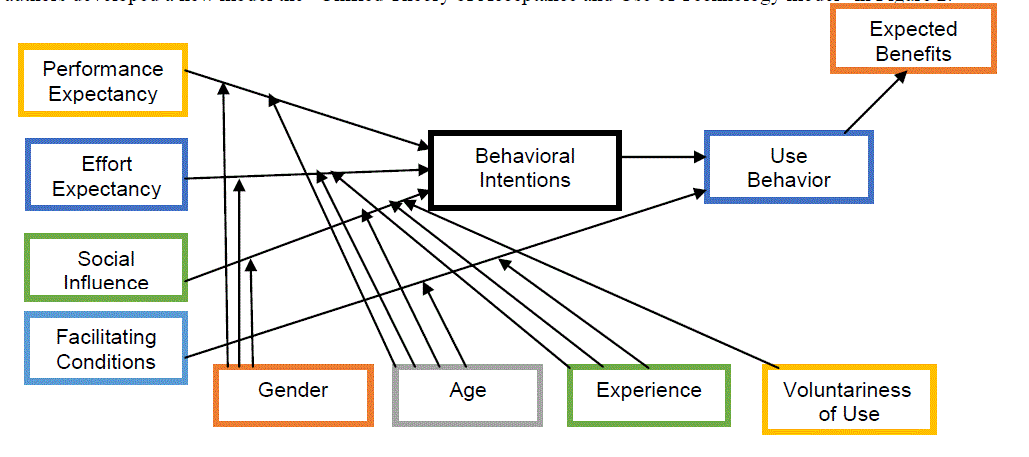 |
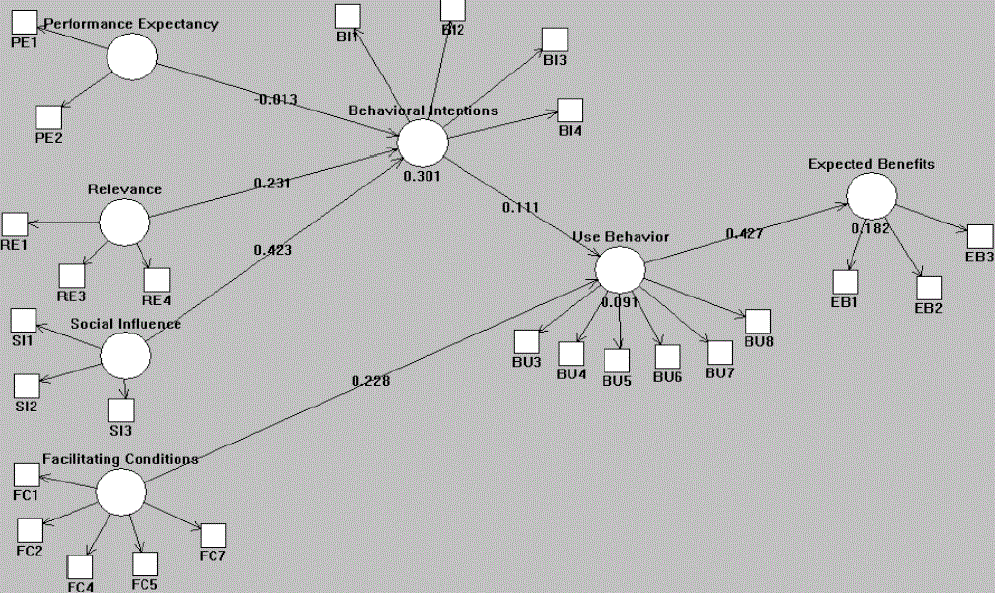 |
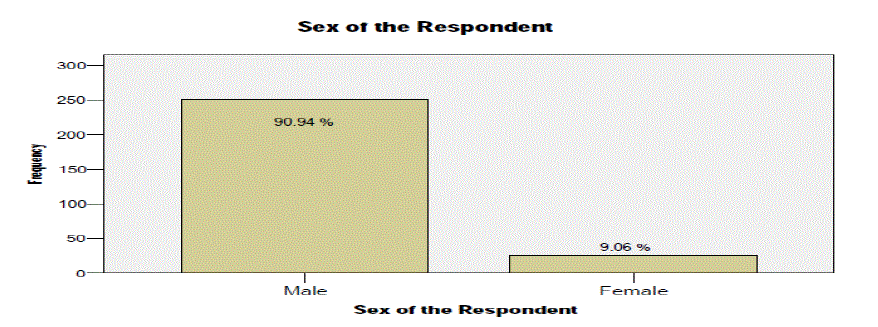 |
| Figure 1 |
Figure 2 |
Figure 3 |
Figure 4 |
|
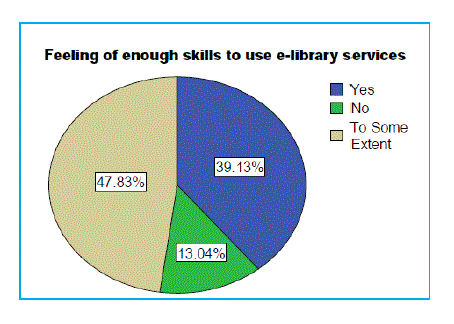 |
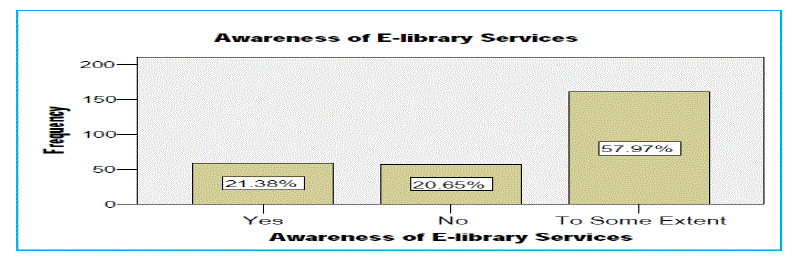 |
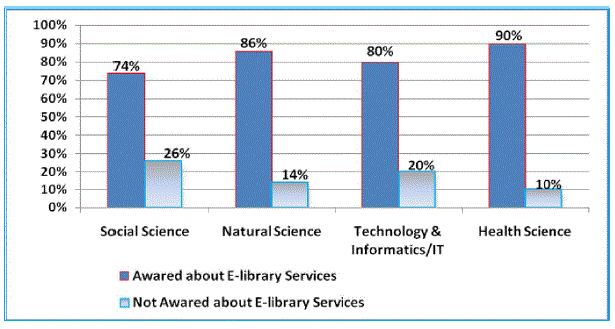 |
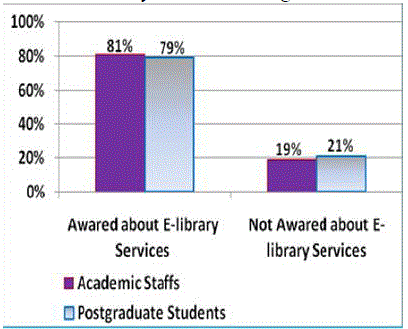 |
| Figure 5 |
Figure 6 |
Figure 7 |
Figure 8 |
|
References
- PriscaTibenderana, Patrick Ogao, J. Ikoja-Odongo and James Wokadala âÃâ¬ÃÅMeasuring Levels of End-UsersâÃâ¬Ã⢠Acceptance and Use of Hybrid Library ServicesâÃâ¬Ã International Journal of Education and Development using Information and Communication Technology (IJEDICT), 2010, Vol. 6, Issue , pp. 33-54.
- NayerehShahmohammadi âÃâ¬ÃÅOn-Line Electronic Journals Use Among University Academic Faculty Members Of Islamic Azad University, Karaj BranchâÃâ¬Ã Asian Journal Of Natural & Applied Sciences, Vol. 1. No.1. March 2012, pp 26-32.
- Venkatesh, V. (2000). âÃâ¬ÃÅDeterminants of perceived ease of use: Integrating control, intrinsic motivation, and emotion into the technology acceptance modelâÃâ¬ÃÂ. Information Systems Research 11: 342âÃâ¬Ãâ365.
- Venkatesh, V., & Davis, F. D. (2000.) âÃâ¬ÃÅA theoretical extension of the technology acceptance model: Four longitudinal field studiesâÃâ¬ÃÂ. Management Science 46(2): 186-204.
- Venkatesh, V., Morris, M. G., Davis, G. B., & Davis, F. D. (2.003) âÃâ¬ÃÅUser acceptance of information technology: Toward a unified viewâÃâ¬ÃÂ. MIS Quarterly 27(3): 425-478.
- Ajzen, I., (1991). The theory of planned behavior. Organizational Behavior and Human DecisionProcesses, vol. 50, no. 2, pp. 179-211.
- Alan, F. (1996). Dhaka University Library Automation (DULA): An Appraisal Report and Proposals for Action. Dhaka.University of Dhaka.
- Anandarajan, M., M. Igbaria, M. &Anakwe, U. P. (2002). IT Acceptance in a Less-Developed Country: A motivational Factor Perspective. International Journal of Information Management, vol. 22, pp: 47-65.
- Anderson, J. E. &Schwager, P. H. (2004). SME Adoption of Wireless LAN Technology: Applying the UTAUT Model. In Proceedings of the 7th Conference of the Southern Association for Information Systems.Retrived on 20 September 2006.
- Bagozzi, R. P. (1992). The self-regulation of attitudes, intentions and behavour. Social Psychology Quarterly, vol. 55, no. 2, pp. 178-204.
- Baba, Z. &Broady, J. (1998). Organisational Effectiveness Assessment: Case Studies of the National Library of Wales and Perpustakaan Negara Malaysia. In: Pat Wressell& Associates,(Ed.). Proceedings of the 2nd Northumbria International Conference on Performance Measurement in Libraries and Information Services.Newcast le Upon Tyne: Information North, pp. 319-339.
- Baruchson-Arbib S. and F. Shor (2002). The Use of Electronic Information Sources by Israeli College Students. The Journal of Academic Librarianship, vol. 28, no. 4, pp. 255-257.
- Bar-Ilan, J., Peritz, B. C. & Wolman, Y. (2003). A Survey on the use of electronic databases and electronic journals accessed through the web by The academic staff of Israeli universities. Journal of Academic Librarianship, vol. 29, no. 6, pp. 346-361.
- Bevis, D. M. & Graham, J. B. (2000). The Evolution of an Integrated Electronic Journal Collection.Journal of Academic Librarianship, vol. 29, no. n2, pp. 115-119.
- Bishop, A. P. (2002). Measuring Access, Use and Success in Digital Libraries.Journal of Electronic Publishing.Retrived on 10 February 2007,
- Brown I., Rijk K. D., Patel K., Twum-Ampofo, Y., & Belle, J. P. (2006). T-Commerce: an Investigation of Non-Adoption in South Africa. Proceedings of the Conference on InformationScience Technology and Management (CISTM2006) Chandigarh, India, July 16-18. Retrieved on 23 June 2007.
- Buttenfield, B. (1999). Usability Evaluation of Digital Libraries. In Digital Libraries: Philosophies, Technical Design Considerations, and Example Scenarios. Ed. D. Stern. New York: Haworth Press.
- Carlsson, C., J. Carlsson, K. Hyvonen, J. Puhakainen, and P. Walden, (2006). Adoption of Mobile Device/Services - Searching for Answers with The UTAUT.In Proceeding of the 39th Hawaii International Conference on System Sciences, pp.1âÃâ¬Ãâ10.
- Chau, P. Y. K. & Hu, P. J. H. (2001). Information technology acceptance by individual professionals: A model comparison approach. Decision Science, vol. 32, no. 4, pp. 699âÃâ¬Ãâ 719.
- Chin, W. W. (1996). The Partial Least Square Approach to Structural Equation Modeling. In Advanced Structural Equation Modelling: Issues and Techniques, pp. 296-335.
- Cody-Allen, E. & Kishore, R. (2005). An Extension of the UTAUT Model with E-Quality, Trust & Satisfaction Constructs.
|